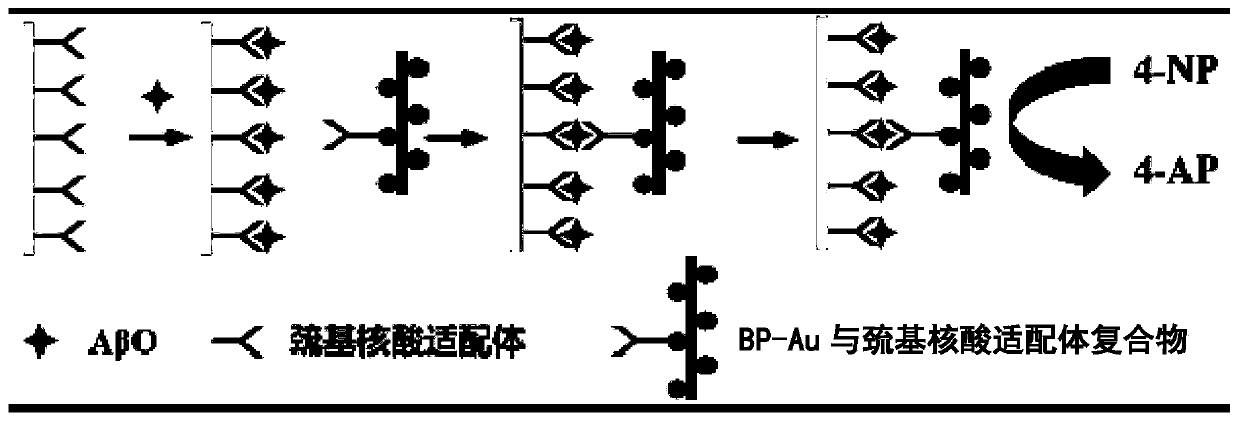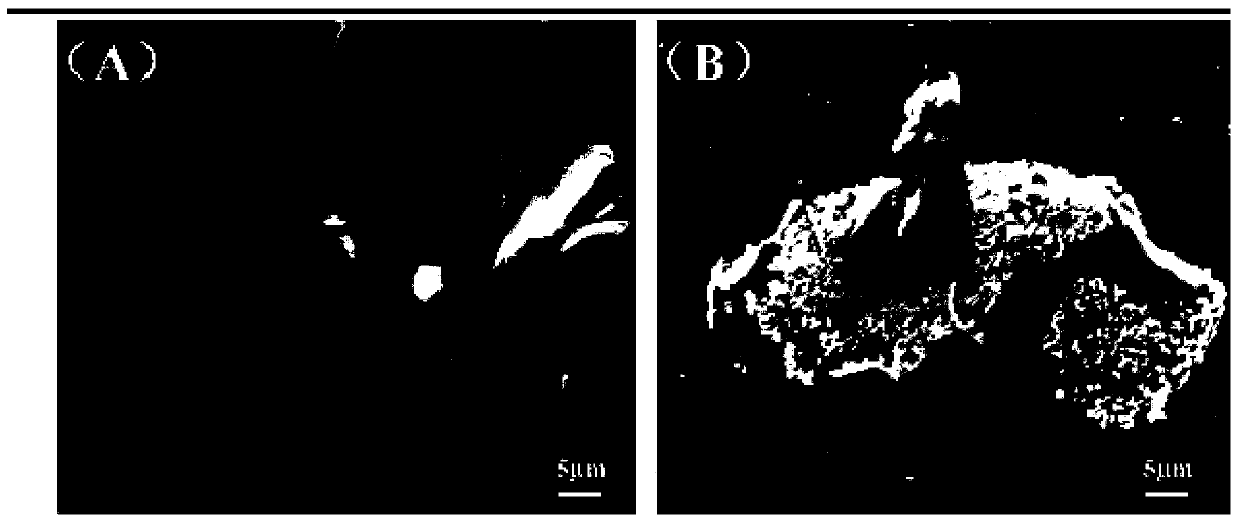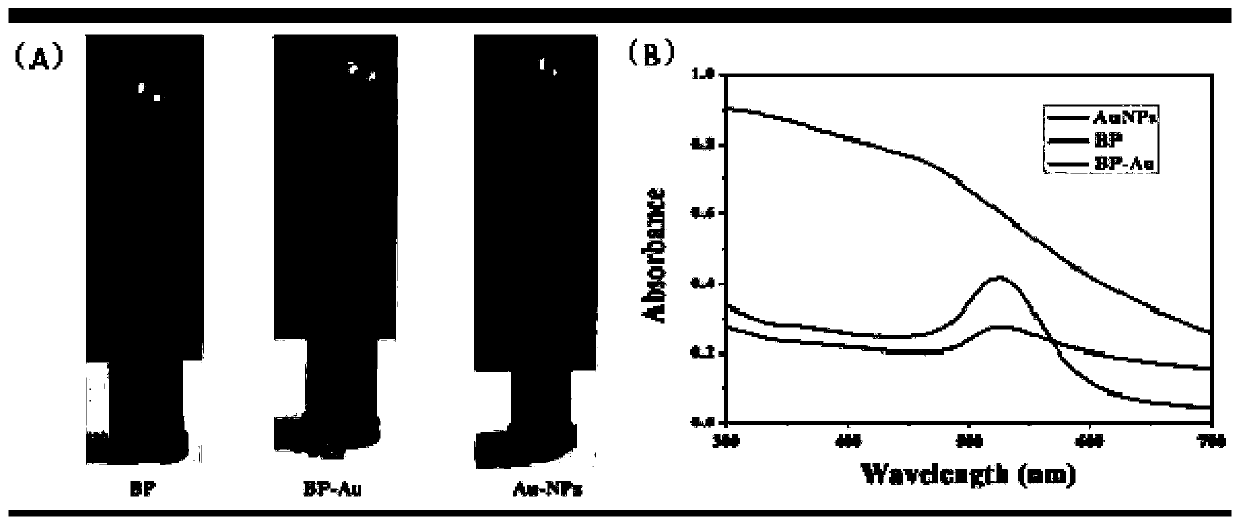Colorimetric biosensor for detecting A beta<1-42> oligomer
A biosensor, oligomer technology, applied in the field of colorimetric biosensors
- Summary
- Abstract
- Description
- Claims
- Application Information
AI Technical Summary
Problems solved by technology
Method used
Image
Examples
Embodiment 1
[0023] Example 1 Preparation of black phosphorene nano-gold composite material (BP-Au)
[0024] (1) The preparation of low-layer black phosphorus (FL-BP) adopts the ultrasonic liquid phase peeling method: accurately weigh 40mL ultrapure water and add 50mL centrifuge tube to Ar gas for 30 minutes, weigh 20mg black phosphorus into the centrifuge tube, Put the black phosphorus mixture into a cell disruptor and sonicate for 5 hours; the sonicated black phosphorus suspension is centrifuged on a high-speed refrigerated centrifuge at 2000 rpm for 10 minutes; after centrifugation, the supernatant and bottom sediment can be observed. Transfer the clear liquid to a new centrifuge tube; continue to place the centrifuge tube containing the supernatant into a high-speed refrigerated centrifuge for centrifugation, set the speed to 10000 rpm for 20 minutes; after the end of centrifugation, obvious supernatant and precipitation can be observed , Pour out the supernatant to retain the precipitate...
Embodiment 2
[0028] Example 2 Preparation of BP-Au colorimetric biosensor
[0029] (1) Prepare a 5'end sulfhydryl modified AβO aptamer TTT TTT TTT TGC CTG TGGTGT TGG GGC GGG TGC G (SEQ ID NO: 01) solution at a concentration of 10 nM.
[0030] (2) Prepare AβO solutions with different concentrations, and set the concentrations as: 0.1 nM, 1 nM, 10 nM, 100 nM, 1 μM. Take six gold-plated silicon wafers numbered 1-6 and drip 20 μL of 10 nM nucleic acid aptamer solution on the gold-plated surface respectively, and incubate for 60 min.
[0031] (3) Add 40 μL of nucleic acid aptamer solution and 80 μL of freshly prepared BP-Au to a 1.5 mL centrifuge tube, incubate for 60 minutes, and centrifuge at 8000 rpm for 5 minutes.
[0032] (4) After the incubation is completed, 10 μL of AβO solution of different concentrations are added dropwise to the gold-plated silicon wafers 1-5, and the concentration is sorted from large to small, and 10 μL of PBS solution is added dropwise to the No. 6 silicon wafer, and incu...
Embodiment 3
[0036] Example 3 Aβ 1-42 Detection of oligomers:
[0037] (1) Prepare Aβ with a concentration of 100nM separately 1-42 Monomers, oligomers, fiber bodies.
[0038] (2) After the gold-plated silicon wafer and the nucleic acid aptamer are incubated, add 10μLAβ to the silicon wafer respectively 1-42 Monomer, oligomer, cellulosic solution, incubate for 60 minutes.
[0039] (3) Add 25 μL of the prepared mixture of aptamer and BP-Au dropwise to the gold-plated silicon wafer, and incubate for 60 minutes.
[0040] (4) Clean the gold-plated silicon wafer with pure water, and perform UV-vis spectrum scanning on 4-NP.
[0041] The result is Figure 5 As shown, the reaction kinetic parameter k is obtained by first-order kinetic fitting at 400 nm. Such as Figure 5 As shown in A, when 100nM AβO is added, it has a catalytic effect on the 4-NP reaction, and the kinetic parameter of the reaction is k = 1.05x10 -5 s -1 , When the sample added is 100nM Aβ 1-42 In the case of monomer or fibrous body, th...
PUM
| Property | Measurement | Unit |
|---|---|---|
| Concentration | aaaaa | aaaaa |
Abstract
Description
Claims
Application Information
 Login to View More
Login to View More - R&D Engineer
- R&D Manager
- IP Professional
- Industry Leading Data Capabilities
- Powerful AI technology
- Patent DNA Extraction
Browse by: Latest US Patents, China's latest patents, Technical Efficacy Thesaurus, Application Domain, Technology Topic, Popular Technical Reports.
© 2024 PatSnap. All rights reserved.Legal|Privacy policy|Modern Slavery Act Transparency Statement|Sitemap|About US| Contact US: help@patsnap.com










